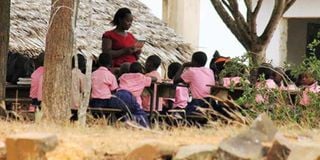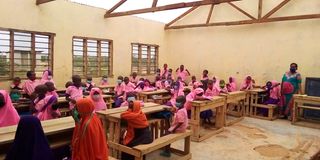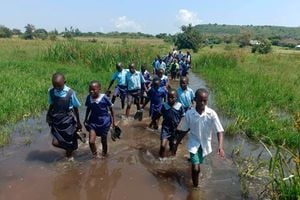
Pupils learning under a tree at Mwangala Primary School in Mtongwe, Mombasa County.
Systemic factors like poor infrastructure, under-staffing and marginalisation lead to low academic achievements among learners, with those from low-income backgrounds most affected, a new report has revealed.
Learners who attend schools that have amenities like libraries, electricity, smaller class sizes, more teachers and reliable supply of clean water perform better than their counterparts in schools that lack the facilities, the report shows.
The study also shows that children from humble backgrounds have delayed entry into formal learning, which affects their learning outcomes and future careers.
Nearly one-third of preschool-age children between four and 15 years are not attending school, indicating a notable challenge in the achievement of universal education, with a substantial 40 per cent of learners in pre-primary school being overage, the report notes.
The Foundational Literacy and Numeracy Assessment report, published by Usawa Agenda, shows that age is a factor in the education outcomes and that 20 per cent of learners in pre-primary one are nine years or older.
Similar overage issues persist in pre-primary two.
Worryingly, the challenges persist into the primary school grades, with five per cent of Grade One learners and two per cent of those in Grade Two being 12 years or older.
Speaking during the release of the report at the Kenya Institute of Curriculum Development in Nairobi on Thursday, Usawa Agenda Executive Director Emmanuel Manyasa said the systemic factors and “inherited illiteracy” lead to low academic achievements.
The report further said children raised by parents with little or no formal education ended up performing poorly compared with those raised by parents with advanced formal education.
“The significance of these findings is magnified as the country grapples with the challenging transition of the first two cohorts of the competency-based curriculum (CBC) learners through junior school, with preparations underway for the pioneer group's transition to senior school by the end of 2025," said Dr Manyasa.
"This period coincides with an ongoing debate surrounding the implementation of the new curriculum, which has evolved from technical viability concerns to issues of resource availability and the overall quality of its execution.

Students at Bula Sukele Primary School in Tana River County, Bura Constituency inside a roofless classroom in this 2021 picture.
"Many argue that these factors could potentially jeopardise the success of the CBC, emphasising the need for comprehensive and effective educational reforms,” he added.
According to data, three per cent of children who discontinued their education in urban areas cited distance to the school as the primary reason for dropping out.
This distance-related dropout rate increased to five in 100 for rural areas. Parental opposition led three in 100 children to drop out, while undisclosed reasons affected three out of 10 cases.
The report noted a decrease in the number of learners attending private schools, giving credence to a story by Daily Nation on Wednesday that a substantial number of parents have ditched private academies for public schools, with many of them citing hard economic times.
Similarly, a comparable percentage discontinued schooling due to parental or guardian reluctance while an equal number who left school did so for reasons that remain undisclosed.
Further, the report shows that, last year, 43 per cent of boys and 47 per cent of girls met expectations in their Grade Six assessment before transiting to junior school, regardless of gender. Only 45 percent of the learners achieved at least the expected level.
The report shows that a significant 40 per cent of learners dropped out due to financial constraints, specifically lack of fees, despite the Free Primary Education programme, while 13 percent chose to discontinue their education on their own.
“A concerning seven in 10 public schools reported incidents of children learning in the open, whereas private schools exhibited a lower rate at 2.5 in 100. Additionally, disparities in facilities are evident, with eight in 10 private schools being fully fenced compared to seven in 10 public schools. Libraries, a crucial resource, were found in two out of 10 schools nationally, with a notable difference between private (four in 10) and public (two in 10) institutions,” said Dr Manyasa.
Children aged four to 15 in arid and semi-arid counties, including Wajir, Tana River West Pokot, Samburu, Turkana, Marsabit and Mandera, face an almost ten times more likely to be out of school compared to those in other regions. The highest proportion of out-of-school children from the same counties have never enrolled in any school.
The distribution of out-of-school children based on county and gender reveals that, among the 46 ranked counties, 11 exhibit a higher percentage of girls out of school compared to boys.
Among boys and girls who had dropped out of school, 35 in 100 boys and 41 in 100 girls achieved the expected level in reading.
Surprisingly, 15 in 100 boys and 17 in 100 girls who never enrolled in school still managed to meet expectations in reading.
“Looking at different school types, 44 in 100 boys and 47 in 100 girls enrolled in private schools achieved the expected level, while 45 in 100 boys and 48 in 100 girls enrolled in public schools reached the same standard. Overall, 46 in 100 enrolled children and 28 in 100 out-of-school children at least met expectations in reading a Grade Three appropriate English text,” said Dr Manyasa.
The teacher-to-pupil ratio across different school locations has emphasised the balance and imbalances in staffing. Rural public primary schools exhibit a ratio of 0.93, while urban schools have a slightly higher ratio of 1.06, indicating that rural schools are generally understaffed in comparison.
“Overall, public schools face a teacher shortage, reflected in the national Permanent and Pensionable teacher-to-classroom ratio of 0.99,” Dr Manyasa noted.
Additional reporting by David Muchunguh










